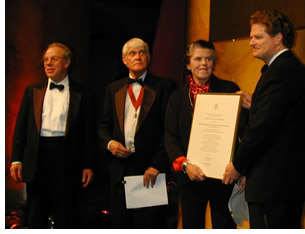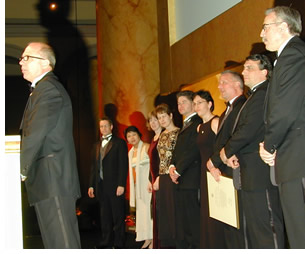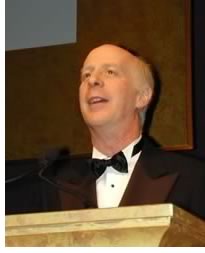

 The
stars of architecture aligned brightly on the American Architectural Foundation
(AAF) and the AIA as together they hosted the 14th annual Accent on Architecture:
A Celebration of Design Excellence gala March 10 at the historic National
Building Museum in the nation’s capital. Harold L. Adams, FAIA,
chair of the AAF Board of Regents, welcomed architects, associates, and
friends who had gathered to celebrate architecture and, in particular,
honored this year’s Twenty-five Year Award and Firm Award winners.
“In a long tradition of architecture, this clearly is an era of
change, for the nation and the American Architectural Foundation,”
Adams said, as he introduced Ronald E. Bogle, the new president and chief
executive officer of the Foundation.
The
stars of architecture aligned brightly on the American Architectural Foundation
(AAF) and the AIA as together they hosted the 14th annual Accent on Architecture:
A Celebration of Design Excellence gala March 10 at the historic National
Building Museum in the nation’s capital. Harold L. Adams, FAIA,
chair of the AAF Board of Regents, welcomed architects, associates, and
friends who had gathered to celebrate architecture and, in particular,
honored this year’s Twenty-five Year Award and Firm Award winners.
“In a long tradition of architecture, this clearly is an era of
change, for the nation and the American Architectural Foundation,”
Adams said, as he introduced Ronald E. Bogle, the new president and chief
executive officer of the Foundation.
 Bogle
in turn thanked Adams for his leadership and vowed to bring renewed energy
and vigor to the AAF’s programs. He introduced two new initiatives
for the Foundation:
Bogle
in turn thanked Adams for his leadership and vowed to bring renewed energy
and vigor to the AAF’s programs. He introduced two new initiatives
for the Foundation:
• National Institute of School Design to inspire passion for lifelong
learning; the new program will use the Mayors' Institute on City Design
as a model
• K–12 Design Education program, for which the AAF will serve
as a catalyst to help students realize the importance of design in their
lives.
AIA Executive Vice President/CEO Norman L. Koonce, FAIA, added his welcome to the audience and to Bogle, saying that the AIA and the AAF together “will strive to inspire the human experience of architecture.” The power of architecture, Koonce said, created the theme for the evening. AIA President Thompson E. Penney, FAIA, added that the AIA and the AAF were great partners and that he looked forward to the opportunity to explore the critical issues of our lives.” Penney reminded all present that the concern and care of the public plays a huge role in the healing power of architecture. He thanked all the gala’s sponsors, notably the principal benefactor, McGraw-Hill Construction Company, whose president, Norbert W. Young Jr., FAIA, expressed his pleasure and hopes for the new AAF initiatives and in turn thanked all the other Accent on Architecture sponsors for their participation.
 Architecture:
How we remember
Architecture:
How we remember
“Architecture is on the minds of Americans today,” master
of ceremonies and broadcast journalist Frank Sesno said in his welcoming
remarks. “Architecture can carry enormous meaning,” he said,
and the discipline is a “good place to start” in finding the
“touchstones of our civilization.” Architecture, Sesno added,
is a symbol of what we were and where we are, and where, as a society,
we are going.
Sesno, who recently developed a documentary on homeland security for The History Channel and is working on a series for PBS, titled “Avoiding Armageddon,” on the subject of terrorism, weapons of mass destruction, and what we can do to turn the tide, talked about his own experiences on September 11. After seeing the Pentagon in flames soon after the impact there, he called in to describe the destruction to CNN, where he had served as senior vice president and Washington bureau chief. He suggested, additionally, that if we are to truly understand our culture and values, we must reflect upon “what our places mean to us” and what role architects can play to “reduce anxiety, restore hope, and to inspire us.”
 “We
cannot remember without her,” Sesno explained, describing the role
architecture plays in reinforcing traditions and speaking to the future.
With this sentiment, he introduced AIA President Thompson E. Penney, FAIA,
to present the Twenty-five Year Award to BTA Architects Inc., formerly
Benjamin Thompson & Associates Inc., for the Design Research Headquarters
Building, Cambridge, Mass. “Remembering is what the Twenty-five
Year Award is about,” for architecture that endures “teaches
timeless lessons and reaches generations long after they are built,”
Sesno said.
“We
cannot remember without her,” Sesno explained, describing the role
architecture plays in reinforcing traditions and speaking to the future.
With this sentiment, he introduced AIA President Thompson E. Penney, FAIA,
to present the Twenty-five Year Award to BTA Architects Inc., formerly
Benjamin Thompson & Associates Inc., for the Design Research Headquarters
Building, Cambridge, Mass. “Remembering is what the Twenty-five
Year Award is about,” for architecture that endures “teaches
timeless lessons and reaches generations long after they are built,”
Sesno said.
Accepting the award, Benjamin Thompson’s widow and partner, Jane, said the “achievement of any building is like a miraculous birth.” With the Design Research building, Thompson said, her husband hoped to create a personal building in the context of a public-minded effort. BTA’s Thomas Green said Thompson hoped to achieve a “non-building” where the merchandise would be the main attraction. Developer William Poorvu said success of the retail building demonstrates that great architecture and great economics can go hand-in-hand.
 Turning
his attention to the AIA’s Firm Award, Sesno lauded winner Miller/Hull
for creating architecture that is responsible and uplifting and that “delights
the eye and elevates the soul.” Speaking about his firm’s
emphasis on Northwest regionalism, Miller/Hull partner Norman Strong said,
“All significant lessons in sustainable architecture come from the
vernacular” and noted that other areas of the country can dictate
their own “regionalism.” Firm founders David Miller and Robert
Hull invited their colleagues to the stage to join in the accolades.
Turning
his attention to the AIA’s Firm Award, Sesno lauded winner Miller/Hull
for creating architecture that is responsible and uplifting and that “delights
the eye and elevates the soul.” Speaking about his firm’s
emphasis on Northwest regionalism, Miller/Hull partner Norman Strong said,
“All significant lessons in sustainable architecture come from the
vernacular” and noted that other areas of the country can dictate
their own “regionalism.” Firm founders David Miller and Robert
Hull invited their colleagues to the stage to join in the accolades.
Sesno then introduced Pulitzer-prize winning keynote speaker Paul Goldberger, Hon. AIA., who tied Sesno’s message of the important symbolism of architecture to the process of selecting plans for the World Trade Center site.
Living in a Great Moment of Architecture
“Great Moments of Architecture take the breath away,” Goldberger
told the audience, and it is times such as these that make it easy to
put those moments aside. Although architecture is not life and death,
“not bread on the table,” great architecture can have a profound
effect on society. There is no better vehicle through which to demonstrate
quality of life. “I’m not sure it always does,” Goldberger
confessed.
The New Yorker architecture critic said that although in dark days it might be easy to set aside, “architecture is even more essential in difficult times” because it can give us a symbol of times to strive for. Goldberger offered an analogy of Abraham Lincoln continuing construction of the great dome for the U.S. Capitol during the Civil War. Lincoln realized what a great symbol the building was, Goldberger explained, and how making a new symbol was as important as rebuilding an old one.
 From
Bilbao to the WTC
From
Bilbao to the WTC
In our time, since the terrorist attacks of 9/11, debate of the World
Trade Center has played out on the public stage, Goldberger said. “However,
architecture was already on the rise of people’s consciousness,”
and people now care about architecture as they never did before. It was
Frank Gehry’s Guggenheim Museum in Bilbao that created high visibility
for architecture and captured the public’s imagination. One result
is more “literate” clients demanding architecture that will
excite. Goldberger declared that the “Age of Architecture is upon
us.” The more exciting architecture is created, the more it will
be in demand.
Although Bilbao brought architecture back into vogue, it is the demise and subsequent recreation design of the World Trade Center that “put architecture on the front page” as never before. Goldberger said that when he served as architecture critic for the New York Times, he sometimes felt like the “sportswriter who covers lacrosse,” whereas the architecture beat now is like “covering the World Series.”
Goldberger also talked about the World Trade Center’s role in the New York City skyline, and how the center’s destruction goes against the grain of urban “Darwinism,” in which older buildings eventually die and are replaced by bigger and stronger buildings. In the case of the World Trade Center, the “biggest things became the most vulnerable.” He explained that people feel a great affection for the skyline as an object, and that the Twin Towers “are our first skyline martyrs.” As such, they are forever out of the range of architectural criticism, as martyrs are not to be criticized. Nonetheless, the World Trade Center symbolized modernity, and Modern architecture now is ultimately tied to the symbols of this country.
 Living
up to the public’s hopes
Living
up to the public’s hopes
Debate about what will replace the World Trade Center is “slouching
toward resolution,” Goldberger explained. He mentioned “Listening
to the City,” a forum through which 5,000 people gathered in New
York City to express their views on the design last July, as a turning
point of the story. Citizens actually were “demanding more vision
and boldness from public officials.” He also cited the televised
public debate over the designs as well as the
Web site that received more than a million hits when it displayed
design alternatives. It is clear, he said, that having lost one symbol,
we need another. Goldberger praised the chosen architect, Daniel Libeskind,
as having a “great gift for the subtle weaving of symbols”
into design.
Now the challenge is to preserve Libeskind’s plan as it travels through the political process. In more universal terms, however, we have to ensure that this “outsurge of public passion for architecture” is kept alive. “Right now, the public is leading us,” Goldberger concluded. Everybody cares, and “the challenge now is making sure that architecture can live up to the public’s hopes for it.”
Copyright 2003 The American Institute of Architects.
All rights reserved. Home Page ![]()
![]()
 |
||
|
|
||